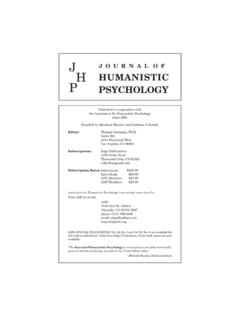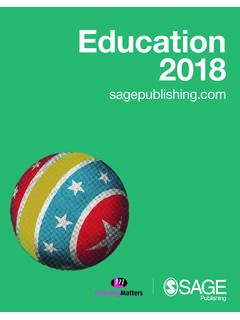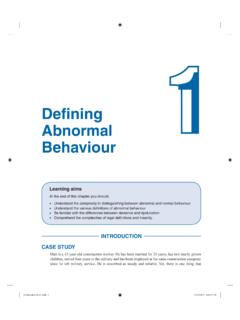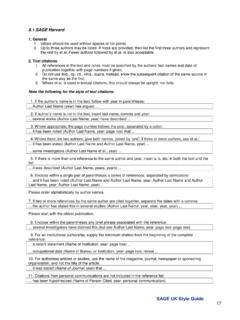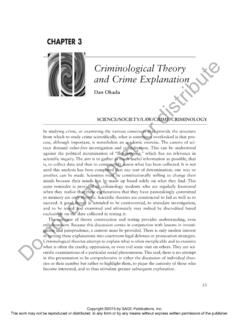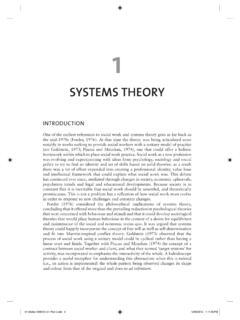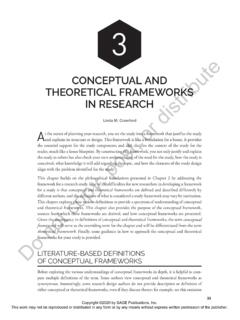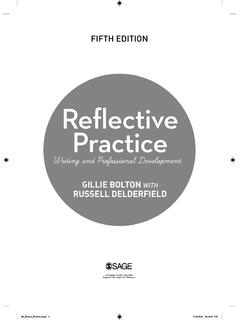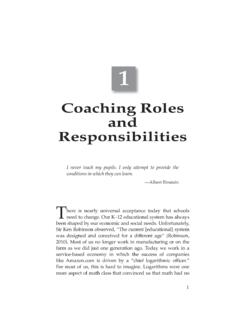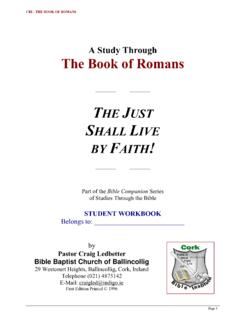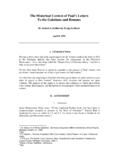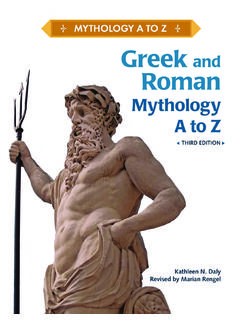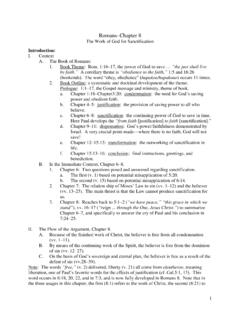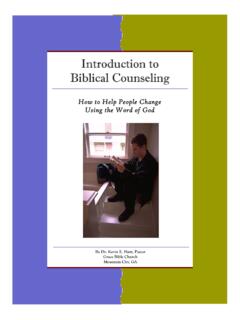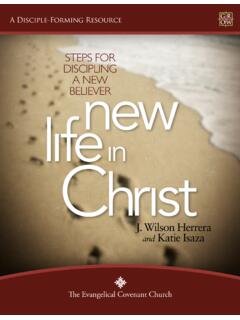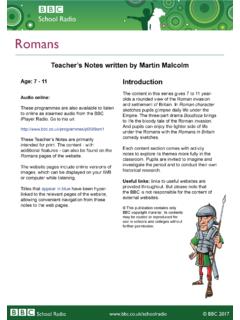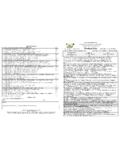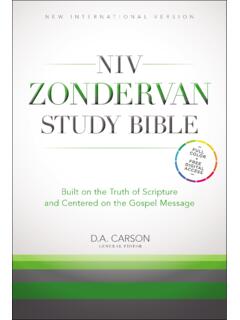Transcription of Introduction to Comparative and International Education ...
1 Introduction to Comparative and International Education Jennifer Marshall 331-Jul-14 2:22:37 PM3AN Introduction TO Comparative EDUCATIONThis chapter explores: What Comparative Education is; How the field has developed over the years; The purpose of Comparative Education ; Who compares; The challenges of undertaking Comparative Defining termsBefore beginning this chapter, write down a definition of Comparative Education . At the end of the chapter, reflect on your definition. Is com-parative Education what you thought? How might this be similar to and different from International Education ? Comparative Education is often used interchangeably with International Education . While these two fields certainly overlap, it can be argued that they are two distinct areas of study.
2 There has been a long history of debate CHAPTER 331-Jul-14 2:22:44 PM4 Introduction TO Comparative AND International Education pertaining to the identity of Comparative and International Education , often called twin fields (Bray, 2010), but what exactly is Comparative Education and how is it different from International Education ? This chapter aims to explain the nature and purpose of Comparative Education . Historical development of Comparative educationIn order to define what the field is today, an understanding of the history shaping it is important. Many contemporary academics argue of the impor-tance in understanding the historical development of Comparative Education in order to appreciate just how far the field has come from its earliest roots.
3 Not only is there disagreement as to the definition of the twin fields, but disparity also exists in identifying their historical roots. How far back does Comparative Education go? When did it emerge as a distinct field of study?Noah and Eckstein (1969) claim that the historical development of com-parative Education can be identified by five distinct stages, each with its own aims. The first stage is often referred to as travellers tales ; stories were brought back from foreign travel and were generally descriptive in nature. When this first stage begins is less clear but for Noah and Eckstein it pre-dates the nineteenth century. Some writers go back as far as ancient times, citing examples from the Greeks and Romans and in particular how they admired the discipline of Spartan Education (Crossley & Watson, 2003, p.)
4 12). According to Phillips (2000), there was a large group of British travel-lers who fell into Noah and Eckstein s first stage. They visited countries such as Germany out of cultural and general curiosity and they wrote with varying degrees of sophistication (Phillips, 2000, p. 49). At this time, these tales did not systematically compare or analyse educational practice so have been dismissed by many scholars. However, others (see Rust, Johnstone & Allaf, 2009) have asserted that while these tales may have been descriptive they had much value and have been harshly judged by those who have a narrow view as to what counts as scholarly Travellers talesHave you ever travelled to another country and come back with an Education -related story to share?
5 Or do you have friends who are from another country? Have they told you about Education in their own coun-try? Why would or wouldn t this be classified as research? The second stage described by Noah and Eckstein (1969) begins from the nineteenth century. This phase coincides with the rise of national Education systems in Europe. During the 1800s countries such as France, Germany and Great Britain were establishing national systems of schooling which 431-Jul-14 2:22:44 PMAN Introduction TO Comparative Education 5eventually became free and universal by the end of the century. Many policy makers had great interest in the organisation and practice of educa-tion in other countries in order to help them devise their own. Noah and Eckstein (1969) argue that the work conducted in this stage was still very similar to the travellers tales in previous years.
6 Many of the writings during this time were encyclopedic descriptions of foreign school systems (Noah & Eckstein, 1969, p. 5) and subjective in nature. These visitors came with a distinct purpose to learn from a foreign example and through such learn-ing to help improve the circumstances in their home countries (Phillips, 2000, p. 49).The third stage occurred around the middle of the nineteenth cen-tury and is still characterised by the accumulation of information in an encyclopaedic manner. However, Noah and Eckstein (1969) suggest that this exchange of scholars, students and publications was in the interest of promoting International understanding rather than in the interest of advancing one s own educational fourth stage begins around the end of the nineteenth century.
7 In this stage, a social science approach was beginning to develop as studies of foreign schooling became to a considerable extent studies of national character and the institutions that help form it (Noah & Eckstein, 1969, p. 6). The recognition of the role of Education in shaping society became important in this stage, as did the idea of cause and effect, and that national character determines Education . The fifth stage occurs after the First World War and coincides with the rise in statistical techniques in the social sciences. The adoption of quan-titative methods after the Second World War and the empirical orientation of the social sciences began to reshape Comparative Education (Noah & Eckstein, 1969).Activity Historic stagesThink about how Comparative Education has developed using Noah and Eckstein s five stages.
8 Can you find any similarities between them and your own academic development? What criticisms can you think of regarding these five stages? Do you think the field developed in a linear fashion? Similarly, in his classic book Comparative Method in Education , Bereday (1964) writes of phases in the history of Comparative Education . However, for Bereday the first phase begins in the nineteenth century and lasts for about 100 years. Like many other scholars ( Green, 2003; Phillips & Schweisfurth, 2008; Acosta & Centeno, 2011), Bereday believes that the Frenchman Marc-Antoine Jullien, or Jullien de Paris, as he is also known, was the first scientifically minded Comparative educator (Bereday, 1964, p. 7). Jullien s aim was to improve French Education by identifying the 531-Jul-14 2:22:44 PM6 Introduction TO Comparative AND International Education best schools in Europe and examining how they were organised, the teaching methods they used and what successful improvements they had implemented.
9 Many writers in the field have called him the father of Comparative Education as he was the first to use the term Comparative Education (Crossley & Watson, 2003) and to use formal models of analy-sis (Gautherin, 1993). In Jullien s book, The Esquisse d un ouvrage sur l ducation compare or Sketch and Preliminary Views on Comparative Education , published in 1817, unlike his predecessors, he provided a systematic Comparative classification of Education systems, based on rudimentary questionnaire surveys (Green, 2003, p. 84). According to Gautherin (1993), by using the Comparative method successfully employed in anatomy, Jullien was trying to advance the science of edu-cation. Although his work was largely neglected throughout his lifetime, the first course on the science of Education was officially introduced at the Sorbonne in Paris in 1883 (Masemann, 2006).
10 Bereday called this first phase in Comparative Education the period of borrowing because comparison of the collected information was then undertaken in order to make available the best practices of one country for transplantation to others (Bereday, 1964, p. 7).Activity Educational borrowingWhat practices do you think early writers in the field reported on? Do you think borrowing these practices and transplanting them in your own country is effective? Why or why not?For Bereday (1964), the second phase, called the period of prediction , occurred during the first half of the twentieth century and was led by the British educationalist Sir Michael Sadler. Like Jullien de Paris, Sadler was also interested in improving the English Education system so looked to other systems, namely those in France, the USA and Germany, in order to draw comparisons.
